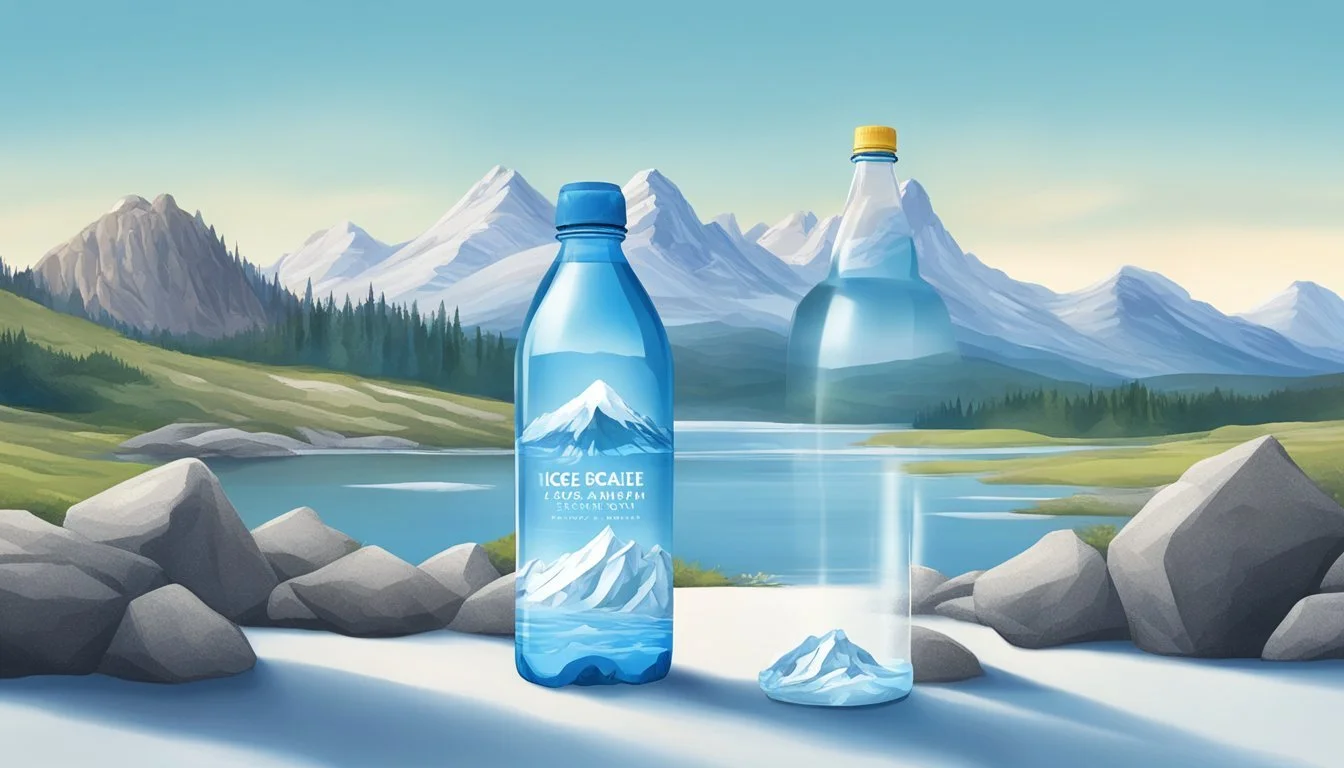Ice Mountain vs. Castle Rock
A Comprehensive Bottled Water Comparison
Comparing Ice Mountain and Castle Rock bottled waters reveals intriguing differences in flavor, source, and quality. Ice Mountain employs a meticulous multi-step filtration process, ensuring purity by removing large particles during the initial phase. This attention to detail results in a clean, refreshing taste appreciated by many.
Castle Rock, sourced from natural springs, offers a crisp and invigorating flavor reminiscent of a morning hike in the mountains. Castle Rock's natural spring source provides a distinct edge in taste and purity that many water aficionados find appealing. Although both brands aim for high standards, Castle Rock’s unprocessed nature sets it apart.
When choosing between Ice Mountain and Castle Rock, taste and source purity are key factors. Consumers who value meticulous filtration might lean towards Ice Mountain, while those who prefer the natural appeal might favor Castle Rock. Each offers unique benefits, making the competition a matter of personal preference.
Understanding Bottled Water
Bottled water has a rich history and comes in many varieties, each regulated to ensure safety and quality. This section explores its journey, types, and the strict regulations governing it.
History and Evolution of Bottled Water
The bottled water industry began in the 18th century with companies like Apollinaris in Germany. Initially, mineral water was valued for its therapeutic benefits and was sold in pharmacies.
In the 20th century, brands like Perrier and Evian popularized bottled water as a lifestyle choice rather than just a health product. By the 1990s, bottled water became mainstream, with consumers appreciating its convenience and perceived purity.
Modern advancements focus on environmentally friendly packaging and enhanced filtration processes, differentiating high-end brands from standard options.
Types of Bottled Water
There are several types of bottled water based on their sources and treatments:
Spring Water: Derived from natural springs, such as Ice Mountain, and typically undergoes minimal processing.
Mineral Water: Contains minerals and trace elements naturally present at the source.
Purified Water: Usually sourced from tap water, then undergoes extensive filtration, such as reverse osmosis.
Artesian Water: Comes from a well tapping a confined aquifer.
Sparkling Water: Carbonated either naturally or artificially.
Each type caters to different preferences, whether it's the mineral content, taste, or carbonation.
Bottled Water Regulations
The safety and quality of bottled water are strictly regulated. In the United States, the Food and Drug Administration (FDA) oversees bottled water, ensuring it meets standards similar to those set by the Environmental Protection Agency (EPA) for tap water.
Regulations require brands to conduct regular testing for contaminants and pathogens. The International Bottled Water Association (IBWA) also sets stringent guidelines for member companies.
Quality reports must be available to consumers, detailing the water's source and any contaminants found, ensuring transparency and trust in the product. These regulations protect consumers by maintaining consistent standards across different bottled water brands.
Ice Mountain and Castle Rock Overview
Ice Mountain and Castle Rock are prominent bottled water brands known for their distinct sources and quality standards. They maintain high purity through rigorous filtration methods and offer unique histories that appeal to different consumers.
Brand Histories
Ice Mountain emerged as a substantial player in the bottled water industry, belonging to the BlueTriton Brands portfolio. Initially targeting the Midwest, Ice Mountain has expanded its distribution nationwide. It is celebrated for its consistent taste and adherence to FDA and IBWA standards.
Castle Rock, on the other hand, prides itself on sustainability and environmental friendliness. Located in Dunsmuir, California, this brand emphasizes eco-friendly practices. Founded in the late 1990s, Castle Rock sets itself apart with its commitment to renewable energy and biodegradable packaging.
Source and Origin
Ice Mountain sources its water from natural springs in Michigan. The region's groundwater is naturally filtered and undergoes additional stringent purification processes. These steps ensure a clean and crisp-tasting water, free from most contaminants.
Castle Rock's water comes from Mount Shasta’s natural springs in Northern California. The water is renowned for its pristine quality, attributed to the volcanic rock filtration. Castle Rock takes pride in its minimally processed water that retains natural minerals, offering a refreshing taste distinct from highly processed brands.
Water Quality and Testing
For consumers considering Ice Mountain and Castle Rock, understanding the various aspects of water quality, such as purity, pH levels, and testing methods, is essential. Each brand undergoes rigorous testing to ensure safety and satisfaction.
Purity and Contaminants
Purity is a crucial factor for both Ice Mountain and Castle Rock. Ice Mountain sources its water from multiple underground springs primarily in the Midwest, ensuring a naturally clean supply. Castle Rock draws its water from pristine aquifers in Mount Shasta, California.
Both brands focus on minimizing contaminants like heavy metals and microorganisms. Testing for pollutants such as lead, arsenic, and other heavy metals is conducted regularly. Consumers can be confident that both brands maintain high purity standards, making their products safe for consumption.
pH Level and Mineral Content
pH levels and mineral content also significantly affect the quality and taste of bottled water. Ice Mountain typically has a pH range between 6.5-7.5, which is slightly acidic to neutral. The mineral content includes calcium and magnesium at moderate levels, contributing to a balanced taste.
Castle Rock water usually has a pH level closer to 8.0, indicating it is more alkaline. This brand boasts higher mineral content, including sodium and potassium, which can enhance hydration benefits. Both brands offer distinct mineral profiles that cater to different preferences and health considerations.
Quality Testing Methods
Quality testing for bottled water involves multiple stages. Ice Mountain employs advanced filtration techniques to ensure the removal of impurities. The water is subjected to continuous monitoring for contaminant levels and compliance with FDA standards.
Castle Rock also follows stringent testing protocols. They utilize ultrafiltration and UV light treatment to maintain water integrity. Regular testing focuses on microbial safety and the elimination of potential health risks.
Detailed and rigorous testing guarantees that both Ice Mountain and Castle Rock meet the highest standards, ensuring consumers receive water of exceptional quality.
Health and Hydration
Understanding the key elements of hydration and the associated health benefits can help make an informed choice between Ice Mountain and Castle Rock bottled water. These brands vary in their mineral content, which directly impacts their hydration effectiveness and health benefits.
Electrolytes and Minerals for Hydration
Electrolytes, such as potassium, are vital for maintaining fluid balance in the body. Ice Mountain and Castle Rock waters contribute to hydration differently based on their mineral compositions.
Ice Mountain provides a range of natural minerals, sourced from Midwest springs. This includes minerals like calcium, magnesium, and potassium which are crucial for effective hydration and muscle function.
Castle Rock prides itself on higher alkalinity due to its volcanic rock filtration process. Higher alkalinity can help with maintaining a balanced pH level in the body, assisting in neutralizing acid and promoting better hydration performance.
Health Benefits of Hydration
Staying hydrated is essential for supporting various bodily functions, including digestion, circulation, and temperature regulation. Adequate hydration aids in nutrient transportation and waste elimination.
Ice Mountain water supports hydration by providing a refreshing, mineral-rich drink. The minerals present, such as magnesium and potassium, help in muscle recovery and maintaining electrolyte balance, essential for active lifestyles.
Castle Rock water, with its high alkalinity, may offer additional health benefits. Alkaline water is believed by some to help reduce acid in the bloodstream, potentially boosting energy levels and supporting a healthier immune system.
Environmental Impact and Sustainability
When comparing Ice Mountain and Castle Rock bottled water, it is crucial to consider their environmental impact and sustainability efforts. This includes examining their bottling processes, plastic usage, and practices in sourcing water.
Bottling Process and Energy Consumption
Ice Mountain primarily uses plastic bottles for packaging their water. This choice requires significant energy for production and results in a considerable carbon footprint due to the lifecycle of plastic. Castle Rock, on the other hand, often utilizes glass bottles, which have a lower environmental impact during production. Glass can be recycled more efficiently and indefinitely, reducing overall energy consumption.
Energy consumption is also influenced by transportation. Castle Rock sources water closer to its bottling facilities, aiming to minimize the carbon emissions associated with transport. Ice Mountain, with larger distribution networks, sometimes incurs higher emissions due to longer transport routes.
Plastic Usage and Recycling
Ice Mountain’s packaging consists mainly of plastic bottles. Despite efforts to use recycled plastic, a large percentage of their packaging remains non-recyclable, contributing to environmental concerns. Plastic waste from these bottles can take centuries to decompose, posing long-term impacts on ecosystems.
Castle Rock emphasizes the use of recyclable materials, with a focus on glass bottles that are more eco-friendly. Glass bottles do not contain BPA and are 100% recyclable. This reduces the plastic waste problem significantly. Furthermore, Castle Rock is exploring biodegradable alternatives for their packaging, which aligns with contemporary environmental sustainability goals.
Sustainable Practices in Water Sourcing
Water extraction methods are pivotal in assessing environmental sustainability. Ice Mountain sources its water from natural springs in the Midwest. While they follow regulations, concerns persist about the depletion of natural spring sources and its impact on local ecosystems.
Castle Rock, alternatively, employs strict sustainability practices, ensuring minimal disruption to natural water cycles. They invest heavily in restoring and maintaining the natural environment around their water sources. This includes initiatives like reforestation and habitat conservation, which help in maintaining the ecological balance and ensuring the long-term viability of water resources.
Both companies strive to mitigate their environmental impact, but their practices and materials differ significantly in effectiveness and long-term sustainability.
Packaging and Distribution
The packaging choices and distribution channels of Ice Mountain and Castle Rock are key factors impacting their convenience and environmental footprint. Differences in materials used and recycling options provide essential information for consumers.
Convenience and Availability
Ice Mountain primarily uses plastic bottles, which are widely distributed across various retail channels. These bottles are made from 100% plastic and are commonly available, ensuring consumers can easily find them.
Conversely, Castle Rock opts for glass bottles, catering to environmentally conscious consumers. Glass bottles, while heavier and potentially more expensive to transport, offer a sustainable packaging choice. Recycled plastic is also sometimes utilized by Castle Rock for its various products, appealing to those looking for eco-friendly options.
Both brands ensure their products are accessible, but the packaging materials influence the overall convenience for consumers.
Taste and Consumer Preference
Taste in bottled water is influenced by various factors including source, mineral content, and any added elements. Here's a closer look at how Ice Mountain and Castle Rock fare in taste profiles and consumer preferences.
Taste Profile Comparisons
Ice Mountain originates from multiple groundwater sources in the Midwest of the United States. It is often praised for its clean and refreshing taste. The water has a balanced pH and moderate mineral content, including calcium, magnesium, and sodium.
Castle Rock, sourced from the Mount Shasta region in California, features a crisp, pure flavor reminiscent of natural spring water. It is typically less mineralized compared to Ice Mountain, which some consumers find more appealing.
Consumer Taste Tests
Consumer taste tests often reveal varied preferences between the two brands. Ice Mountain's taste is described as fresh and natural, appealing to those who enjoy a slightly mineralized profile. This makes it popular in blind taste tests.
Castle Rock, with its cleaner and crisper taste, often wins over consumers looking for a more straightforward, pure water experience. Its lower mineral content can be a deciding factor for those who prefer a less complex taste.
Expert Opinions
Experts, including water sommeliers, often evaluate bottled water based on clarity, mineral balance, and overall flavor profile. Ice Mountain’s mix of minerals giving it a subtly balanced flavor is sometimes highlighted by experts.
Castle Rock, on the other hand, is frequently noted for its pristine quality and simple taste. Its reputation for being one of the purest spring waters makes it a favorite among experts who recommend water with minimal additives and clear, crisp profiles.
By understanding these details, consumers can make more informed choices based on their specific taste preferences.
Comparative Analysis
This section explores the price, value, comparative advantages, and recommendations for choosing between Ice Mountain and Castle Rock bottled water brands.
Price and Value
Ice Mountain is positioned as a budget-friendly option among bottled waters. It is broadly available in various sizes, offering good value especially for families or individuals who purchase in bulk.
In contrast, Castle Rock often targets the premium market. Known for its eco-friendly practices and glass packaging, it typically comes at a higher price point. While some may see this as an added expense, others consider it an investment in high-quality and sustainable water.
Comparative Advantages
Ice Mountain sources its water from natural springs in the Midwest. This ensures a consistent and reliable taste profile. Their multi-step filtration process guarantees purity and safety.
Castle Rock, derived from high-altitude springs in California, prides itself on minimal processing. The water is rich in natural minerals, giving it a distinct, crisp taste. The use of glass bottles further reduces the risk of contamination from plastics, appealing to health-conscious consumers.
Recommendations
For budget-conscious buyers or those seeking practical, everyday drinking water, Ice Mountain presents a strong choice. Its availability and competitive pricing make it a convenient option.
Castle Rock appeals more to those prioritizing sustainability and premium quality. The brand's commitment to eco-friendly packaging and natural mineral content make it a preferred choice for consumers willing to pay a premium for these benefits.
Conclusion
When comparing Ice Mountain and Castle Rock bottled water, several factors stand out.
Source
Ice Mountain sources its water from underground springs in the Midwest, while Castle Rock draws from a secluded spring in Northern California.
Taste
Ice Mountain offers a clean taste with a hint of minerality. Castle Rock is known for its crisp profile and subtle natural flavor.
Mineral Content
Ice Mountain contains a balanced blend of minerals, providing a moderate taste profile. Castle Rock’s mineral content is slightly higher, emphasizing purity and natural composition.
Environmental Impact
Castle Rock emphasizes sustainability with eco-friendly packaging, while Ice Mountain has initiatives focusing on water stewardship.
Price
Ice Mountain's price ranges between $3.50-$5.00 for a 24-pack of 16.9oz bottles. Castle Rock tends to be more premium-priced, reflecting sourcing and sustainability efforts.
Availability
Ice Mountain is widely available across the United States. Castle Rock's distribution is more localized but expanding.
Each brand has its strengths, making the choice between Ice Mountain and Castle Rock largely a matter of personal preference and values.
More About Ice Mountain
Core Hydration vs Ice Mountain: Which Bottled Water is Better?
Ice Mountain vs Aqua Carpatica: Which Bottled Water is Better?
Ice Mountain vs Cascade Mountain: Which Bottled Water is Better?
Ice Mountain vs Crystal Geyser: Which Bottled Water is Better?
Ice Mountain vs Crystal Lake: Which Bottled Water is Better?
Ice Mountain vs Essence pH10: Which Bottled Water is Better?
Ice Mountain vs Hawaii Volcanic: Which Bottled Water is Better?
Ice Mountain vs Hawaiian Springs: Which Bottled Water is Better?
Ice Mountain vs Icelandic Glacial: Which Bottled Water is Better?
Ice Mountain vs Kirkland Signature: Which Bottled Water is Better?
Ice Mountain vs Liquid Death: Which Bottled Water is Better?
Ice Mountain vs Mountain Valley Spring Water: Which Bottled Water is Better?
Ice Mountain vs Nestle Pure Life: Which Bottled Water is Better?
Ice Mountain vs Poland Spring: Which Bottled Water is Better?
Ice Mountain vs Proud Source: Which Bottled Water is Better?
Ice Mountain vs Purely Sedona: Which Bottled Water is Better?
Ice Mountain vs Richard's Rainwater: Which Bottled Water is Better?
Ice Mountain vs San Pellegrino: Which Bottled Water is Better?
Ice Mountain vs Simple Truth: Which Bottled Water is Better?
Ice Mountain vs Solan de Cabras: Which Bottled Water is Better?
Ice Mountain vs Talking Rain AQA: Which Bottled Water is Better?
Ice Mountain vs Whole Foods 365: Which Bottled Water is Better?
Ice Mountain vs Whole Foods Italian Still Mineral water: Which Bottled Water is Better?
More About Castle Rock
Aqua Carpatica vs Castle Rock: Which Bottled Water is Better?
Castle Rock vs Cascade Mountain: Which Bottled Water is Better?
Castle Rock vs Crystal Geyser: Which Bottled Water is Better?
Castle Rock vs Hawaii Volcanic: Which Bottled Water is Better?
Castle Rock vs Hawaiian Springs: Which Bottled Water is Better?
Castle Rock vs Kirkland Signature: Which Bottled Water is Better?
Castle Rock vs Purely Sedona: Which Bottled Water is Better?
Castle Rock vs Richard's Rainwater: Which Bottled Water is Better?
Castle Rock vs Solan de Cabras: Which Bottled Water is Better?
Castle Rock vs Talking Rain AQA: Which Bottled Water is Better?
Castle Rock vs Whole Foods 365: Which Bottled Water is Better?
Castle Rock vs Whole Foods Italian Still Mineral water: Which Bottled Water is Better?
Core Hydration vs Castle Rock: Which Bottled Water is Better?
Icelandic Glacial vs Castle Rock: Which Bottled Water is Better?
Mountain Valley Spring Water vs Castle Rock: Which Bottled Water is Better?
Nestle Pure Life vs Castle Rock: Which Bottled Water is Better?
Poland Spring vs Castle Rock: Which Bottled Water is Better?
San Pellegrino vs Castle Rock: Which Bottled Water is Better?







